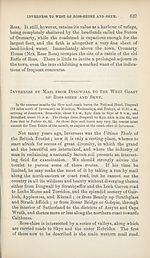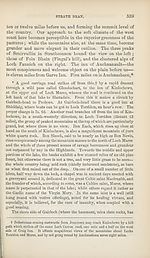Download files
Complete book:
Individual page:
Thumbnail gallery: Grid view | List view

538
INVERNESS TO WEST OF
3-SHIRE AND SKYE.
As far as Strathpeffer (five miles) there extends a fine arable
flat, bordered on the one hand by the sunny braes which lead
up to a higher plateau, from which springs the mighty irregular
dome of Ben Wyvis (Ben Uaish, the mountain of storms), and
on the opposite by the ridge of Knockfarrel (a large and interest¬
ing vitrified fortress), which conceals from view the woods and
policies of Brahan Castle, the seat of Mackenzie of Seaforth.
On the high ground lies the picturesque Italian looking lake of
Ousie. Castle Leod, an old abode of the Earls of Cromarty
(now represented by the Marchioness of Stafford), stands near
the further end of the Strath, passing which, the road ascends
a ridge studded with the villas built round the mineral wells
of Strathpeffer. This quarter of the country was the scene of
two desperate clan battles fought in the end of the fifteenth
century—the one between the Mackenzies and the Macdonalds
of the Isles, and the other between the Mackenzies and the
Munros of Ferindonald, in both of which the “ Caberfaeh” was
victorious. The Spa Hotel or Inn of Balarnacsen is half a mile
past the pump-room.
Quitting the first valley, the road immediately enters on
that of Contin and Coul (Sir Alexander Mackenzie, Bart.),
which is encircled by as beautifully clad birch and pine woods,
and hills of diversified forms and features, as are to be seen in
any part of the Highlands. We then cross the Blackwater
at the bridge and inn of Contin, and on the left pass Loch
Echiltie, a most enchanting little lake. Our course turns
suddenly northwards, and, after breasting a steepish ascent
overhung with oaks and weeping birch trees, and giving us a
peep of the falls of Rogie below on the right, ushers us on the
great upland moorish pastures, and Loch Garve.* Ascending
westwards, we soon reach Loch Luichart, around which are the
shooting grounds and deer forest of Sir James J. R. Mackenzie
of Scatwell, Bart. The lodge is at the further end.
Two miles on, at the bridge of Grudie, the water of that
name comes tumbling down on the right from Loch Fannich,
and here we ascend through a small birch wood and the remains
of an ancient oak forest, until, emerging from an inclined rocky
pass, we enter Strath Bran, a great open plain, stretching for
* From the inn of Garve, thirteen miles from Dingwall, a road proceeds north¬
wards to Loch Broom—more particularly noticed afterwards.
INVERNESS TO WEST OF
3-SHIRE AND SKYE.
As far as Strathpeffer (five miles) there extends a fine arable
flat, bordered on the one hand by the sunny braes which lead
up to a higher plateau, from which springs the mighty irregular
dome of Ben Wyvis (Ben Uaish, the mountain of storms), and
on the opposite by the ridge of Knockfarrel (a large and interest¬
ing vitrified fortress), which conceals from view the woods and
policies of Brahan Castle, the seat of Mackenzie of Seaforth.
On the high ground lies the picturesque Italian looking lake of
Ousie. Castle Leod, an old abode of the Earls of Cromarty
(now represented by the Marchioness of Stafford), stands near
the further end of the Strath, passing which, the road ascends
a ridge studded with the villas built round the mineral wells
of Strathpeffer. This quarter of the country was the scene of
two desperate clan battles fought in the end of the fifteenth
century—the one between the Mackenzies and the Macdonalds
of the Isles, and the other between the Mackenzies and the
Munros of Ferindonald, in both of which the “ Caberfaeh” was
victorious. The Spa Hotel or Inn of Balarnacsen is half a mile
past the pump-room.
Quitting the first valley, the road immediately enters on
that of Contin and Coul (Sir Alexander Mackenzie, Bart.),
which is encircled by as beautifully clad birch and pine woods,
and hills of diversified forms and features, as are to be seen in
any part of the Highlands. We then cross the Blackwater
at the bridge and inn of Contin, and on the left pass Loch
Echiltie, a most enchanting little lake. Our course turns
suddenly northwards, and, after breasting a steepish ascent
overhung with oaks and weeping birch trees, and giving us a
peep of the falls of Rogie below on the right, ushers us on the
great upland moorish pastures, and Loch Garve.* Ascending
westwards, we soon reach Loch Luichart, around which are the
shooting grounds and deer forest of Sir James J. R. Mackenzie
of Scatwell, Bart. The lodge is at the further end.
Two miles on, at the bridge of Grudie, the water of that
name comes tumbling down on the right from Loch Fannich,
and here we ascend through a small birch wood and the remains
of an ancient oak forest, until, emerging from an inclined rocky
pass, we enter Strath Bran, a great open plain, stretching for
* From the inn of Garve, thirteen miles from Dingwall, a road proceeds north¬
wards to Loch Broom—more particularly noticed afterwards.
Set display mode to:
![]() Universal Viewer |
Universal Viewer | ![]() Mirador |
Large image | Transcription
Mirador |
Large image | Transcription
| Antiquarian books of Scotland > Scotland/Scots > Black's picturesque tourist of Scotland > (672) |
|---|
| Permanent URL | https://digital.nls.uk/130036254 |
|---|
| Description | Thousands of printed books from the Antiquarian Books of Scotland collection which dates from 1641 to the 1980s. The collection consists of 14,800 books which were published in Scotland or have a Scottish connection, e.g. through the author, printer or owner. Subjects covered include sport, education, diseases, adventure, occupations, Jacobites, politics and religion. Among the 29 languages represented are English, Gaelic, Italian, French, Russian and Swedish. |
|---|

